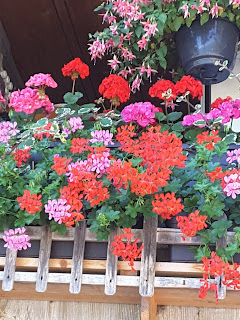The Swiss raise some corn and wheat in the lower elevations and the wheat is now a brilliant gold with the harvest in progress. Compared to Nebraska, the fields are small but they add bright splashes of gold to the otherwise green landscape.
We took the 100 km (60 mile) slow route passing through Interlaken and then along the north side of lake Thun (to the city of Thun) and then north to the small village of Lauperswil. Our one bedroom apartment (with livingroom, kitchen, and bath) is on the 2nd level of our hosts home. Jurg and Heidi live on the ground level with their son and 19 year old twin daughters.
You will notice in the pictures that Lake Brienz has a green hue This is due to the milky glacial water that feeds the lake and the effect on the reflected sunlight. The ice at the bottom of the glaciers in the Alps grind the rocks into a fine flour like powder that stays suspended in the water for a long time and give the river a milky color. The flour reflects the green part of the spectrum.
In this screen shot, you can see the difference in the color of Lake Brienz and Lake Thun (in the middle). Much of the glacial flower has settled out before the water flows through Interlaken into Lake Thun. The snow in the Alps is visible in the lower right. The small blue circle east of Bern is our current location.
Small villages line the shores of both Lake Brienz and Lake Thun (connected by the Aare River which flows first into Lake Brienz and then through Interlaken into Lake Thun.
These pictures were taken in the village of Iseltwald on the southern shore of Lake Brienz. If you look close you can see the villages on the opposite shore.
Part of the charm of Switzerland is, of course, the flower boxes with the brightly colored flowers (most often geraniums).
They like to put flowers in nooks and crannys on the barns to brighten them up.
Different regions in Swizerland have different styles of homes. This style is common in the Emmental - the Emmentaler Bauernhaus.








